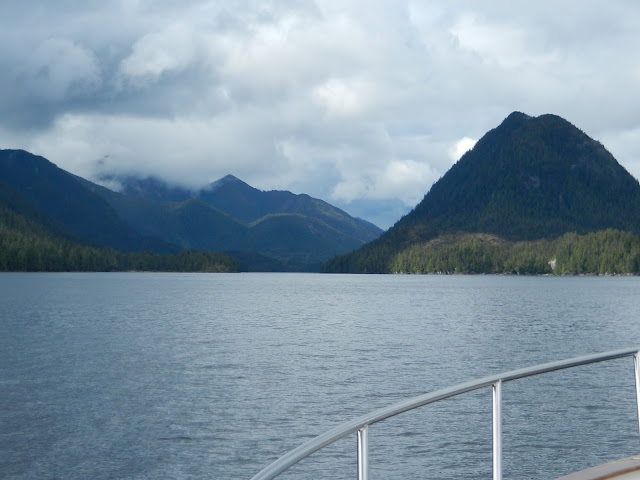 |
| Port McNeill Area Map |
After
a beautiful sunrise at Port Neville we left our anchorage at 7am for the
five-hour cruise to Port McNeill. Once
again the weather was pleasant with calm seas which is not necessarily the norm
for Johnston Strait. The winds began to
blow that evening however, requiring a layover until seas subside. In the meantime, we are making use of the
marina’s courtesy van to enjoy some land-based day trips.
 |
| Neroutsos Inlet at Port Alice |
This morning we drove to Port Alice located
southwest of Port McNeill on Neroutsos Inlet.
Port Alice is accessed by boat from the west side of Vancouver Island
via Quatsino Sound.
In years past, we
have cruised the west side of Vancouver Island and have gone into all five of
the sounds that indent the coast line and some of their inlets leading many miles across
Vancouver Island.
We are always amazed how far these inlets cut into the Island.
In this case, Port Alice is only 30 miles
from Port McNeill by land.
 |
| Neucel Pulp Mill, Port Alice |
Port Alice is
the site of a pulp mill at the head of Neroutsos Inlet that was constructed in
1916 and became operational in 1918.
Pulp mills convert wood chips or other plant fiber (cellulose) into
thick fiber board which can then be shipped to a paper mill for further
processing.
Cellulose fibers are used in
textiles, paper, and diapers among other products.
The town first began with a row of houses and
several bunkhouses placed a few hundred yards from the mill.
The original community was a company town
that boasted a movie theatre, bowling alley, and golf course; later adding
a hospital, bank, library, and school.
During the 1960’s some residents wanted to own their own homes and the
company needed room to expand and modernize the mill.
 |
| Neucel Pulp Mill, Port Alice |
In 1965 a new community developed four miles
to the north at present day Rumble Beach, now called Port Alice.
All that remains of the old town is the mill
itself and the adjacent golf course.
We
met one of the friendly locals in town who told us she and her husband had moved from
the prairies to Port Alice over 20 years ago and that her husband had worked in the mill.
With disappointment in her
voice, she said the mill had closed just two years ago and that many of the folks
have started to leave town in search of other places to live.
 |
| Moorage Docks at Port Alice |
Who knows, perhaps Port Alice will one day
become a ghost town as has happened to other mill towns of the 60’s era in northern
British Columbia’s remote areas.
We drove
back to the boat for lunch at Port McNeill and then left again in the afternoon
to visit Telegraph Cove, located 15 miles east.
 |
| Telegraph Cove |
Telegraph Cove served as a telegraph station (built in 1911) as the
northern terminus of the Campbell River telegraph line, sending and receiving
Morse code signals.
Area pioneer Marmaduke
(Duke) Wastell established a saw mill in 1922 and a chum salmon saltery first begun
by Charlie Nakamura.
 |
| Boardwalk, Telegraph Cove |
Duke’s
brother-in-law, Jim Sharpe, left a flourishing boat shop and marine ways in nearby
Alert Bay to become the millwright at Telegraph Cove.
Jim made wooden pulleys, friction drives, and
two-wheeled lumber carts seen on the boardwalk today.
Later, Duke’s son Fred Wastell and partner
Alex Macdonald expanded and carried on the business of the lumber mill.
 |
| Homes and Buildings on pilings at Telegraph Cove |
The mill provided lumber for many of the
buildings constructed throughout the northern end of Vancouver Island and
operated for more than 50 years.
During
WWII, the military commandeered the mill and used whatever the mill could cut; finding
able-bodied men to do the work was a challenge since most men had been sent off
to war and the Japanese workers and families were evicted by the Canadian
Government.
To meet the need, sixty-five
airmen were sent to staff and operate the mill.
In early 1946, the mill was returned to Fred Wastell and his partner
Alex Macdonald.
Many of the original
mill worker’s homes remain on the boardwalk surrounding the cove and are now
quaint accommodations along with a pub and a couple of café’s.
 |
| Skeleton of a Juvenile Fin Whale |
Telegraph Cove serves as a charming
resort offering fishing tours, bear watching tours, whale watching, and kayak
tours.
Telegraph Cove is also home to an
excellent Whale Interpretive Centre, providing fascinating displays and
educational programs.























































